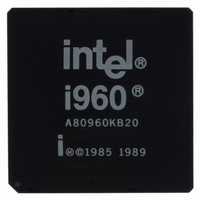A80960KB20 Intel, A80960KB20 Datasheet - Page 15

A80960KB20
Manufacturer Part Number
A80960KB20
Description
IC MPU I960KB 20MHZ 132-PGA
Manufacturer
Intel
Datasheet
1.A80960KB20.pdf
(44 pages)
Specifications of A80960KB20
Processor Type
i960
Features
KB suffix, 32-Bit, 512 Byte Cache
Speed
20MHz
Voltage
5V
Mounting Type
Surface Mount
Package / Case
132-PGA
Family Name
i960
Device Core Size
32b
Frequency (max)
20MHz
Instruction Set Architecture
RISC
Supply Voltage 1 (typ)
5V
Operating Supply Voltage (max)
5.25V
Operating Supply Voltage (min)
4.75V
Operating Temp Range
0C to 85C
Operating Temperature Classification
Commercial
Mounting
Through Hole
Pin Count
132
Package Type
PGA
Lead Free Status / RoHS Status
Lead free / RoHS Compliant
Other names
803516
Available stocks
Company
Part Number
Manufacturer
Quantity
Price
BADAC
RESET
I/O = Input/Output, O = Output, I = Input, O.D. = Open Drain, T.S. = Three-state
BE3:0
HOLD
HLDA
CACHE
I/O = Input/Output, O = Output, I = Input, O.D. = Open Drain, T.S. = Three-state
NAME
NAME
TYPE
TYPE
O.D.
T.S.
T.S.
O
O
O
Table 5. 80960KB Pin Description: Support Signals (Sheet 1 of 2)
I
I
I
Table 4. 80960KB Pin Description: L-Bus Signals (Sheet 2 of 2)
BAD ACCESS, if asserted in the cycle following the one in which the last READY
of a transaction is asserted, indicates that an unrecoverable error has occurred
on the current bus transaction or that a synchronous load/store instruction has not
been acknowledged.
During system reset the BADAC signal is interpreted differently. If the signal is
high, it indicates that this processor will perform system initialization. If it is low,
another processor in the system will perform system initialization instead.
RESET clears the processor’s internal logic and causes it to reinitialize.
During RESET assertion, the input pins are ignored (except for BADAC and
IAC/INT
other output pins are placed in their non-asserted states.
RESET must be asserted for at least 41 CLK2 cycles for a predictable RESET.
The HIGH to LOW transition of RESET should occur after the rising edge of both
CLK2 and the external bus clock and before the next rising edge of CLK2.
BYTE ENABLE LINES specify the data bytes (up to four) on the bus which are
used in the current bus cycle. BE3 corresponds to LAD31:24; BE0 corresponds to
LAD7:0.
The byte enables are provided in advance of data:
Byte enables asserted during T
Byte enables asserted during T
(the word to be transmitted following the next assertion of READY).
Byte enables that occur during T
READY are undefined. Byte enables are latched on-chip and remain constant
from one T
For reads, byte enables specify the byte(s) that the processor will actually use.
L-Bus agents are required to assert only adjacent byte enables (e.g., asserting
just BE0 and BE2 is not permitted) and are required to assert at least one byte
enable. Address bits A
HOLD: A request from an external bus master to acquire the bus. When the
processor receives HOLD and grants bus control to another master, it floats its
three-state bus lines and open-drain control lines, asserts HLDA and enters the
T
T
HOLD ACKNOWLEDGE: Notifies an external bus master that the processor has
relinquished control of the bus.
CACHE indicates when an access is cacheable during a T
asserted during any synchronous access, such as a synchronous load or move
instruction used for sending an IAC message. The CACHE signal floats to a high
impedance state when the processor is idle.
i
h
or T
state. When HOLD deasserts, the processor deasserts HLDA and enters the
a
state.
0
), the three-state output pins are placed in a high impedance state and
d
cycle to the next when READY is not asserted.
0
and A
1
a
d
can be decoded externally from the byte enables.
d
DESCRIPTION
specify the bytes of the first data word.
DESCRIPTION
specify the bytes of the next data word, if any
cycles that precede the last assertion of
a
cycle. It is not
80960KB
9













